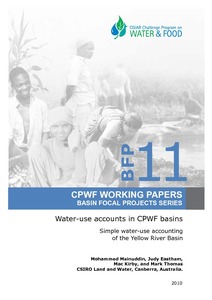Resource information
This paper applies the principles of water-use accounts, developed in the first of the
series, to the Yellow River basin in China. The Yellow River rises in the Bayan Har
Mountains in Qinghai Province in western China, and empties into the Bohai Sea. A
unique feature of the river is the large amount of silt it carries.
Net runoff is about 14% of total precipitation. Forest and woodland cover 9% of the
basin and use about 15% of the precipitation. Grassland covers much of the upper part
of the Basin, consuming about 42% of the precipitation. Irrigated agriculture covers just
6% of the Basin and uses about 11% of the water.
The effect of increased irrigation efficiency shows that local increase of irrigation
efficiency does not necessarily translate into changes at the whole basin level. The
water transfer to the Yellow River from the Yangtze boost flows to the upper Yellow river
and leads to an increase in the flows throughout the river.
Keywords: Water use accounts, Yellow basin, top-down modeling, basin water use


